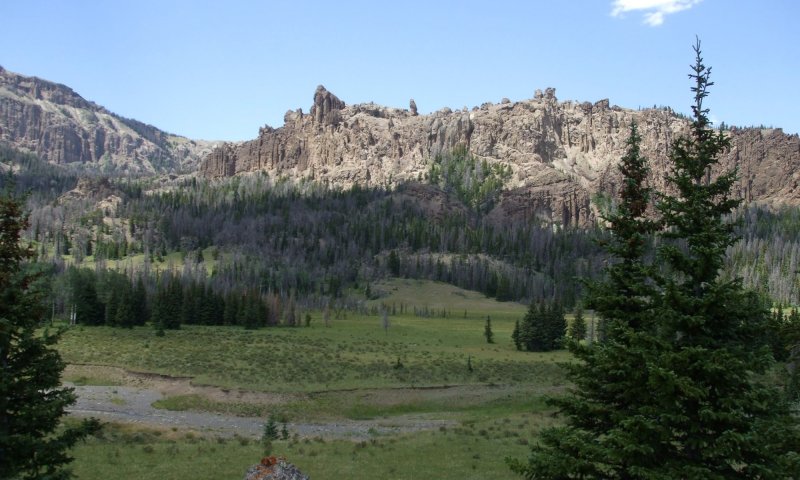

Natural Resources
Conservation Service
Ecological site F043BP707WY
Subirrigated Cool Woodland Group
Last updated: 4/16/2025
Accessed: 12/21/2025
General information
Provisional. A provisional ecological site description has undergone quality control and quality assurance review. It contains a working state and transition model and enough information to identify the ecological site.
MLRA notes
Major Land Resource Area (MLRA): 043B–Central Rocky Mountains
043B – Central Rocky Mountains – This MLRA is extensive including Montana, Idaho, Wyoming and a small portion in Utah. This MLRA consists of the major chains of Mountain Ranges with the corresponding valleys. Cartographic standards limited the ability to capture the foothills as a separate MLRA, so revisions of the MLRA boundaries in 2006 led to the inclusion of the foothills with the mountains for much of Wyoming.
Further information regarding MLRAs, refer to: United States Department of Agriculture, Natural Resources Conservation Service. 2006. Land Resource Regions and Major Land Resource Areas of the United States, the Caribbean, and the Pacific Basin. U.S. Department of Agriculture Handbook 296. Available electronically at: http://www.nrcs.usda.gov/wps/portal/nrcs/detail/soils/ref/?cid=nrcs142p2_053624#handbook.
LRU notes
LRU P: PES (Provisional Ecological Site or Group - PEG) A PROVISIONAL ECOLOGICAL SITE is a conceptual grouping of soil map unit components within a Major Land Resource Area
(MLRA) based on the similarities in response to management. Although there may be wide variability in the productivity of the soils grouped into a Provisional Site, the soil vegetation
interactions as expressed in the State and Transition Model are similar and the management actions required to achieve objectives, whether maintaining the existing ecological state or managing for an alternative state, are similar. Provisional Sites are
likely to be refined into more precise concept during the process of meeting the APPROVED ECOLOGICAL SITE DESCRIPTION criteria.
This PROVISIONAL ECOLOGICAL SITE has been developed to meet the standards established in the National Ecological Site Handbook. The information associated with this ecological site does not meet the Approved Ecological Site Description Standard,
but it has been through a Quality Control and Quality Assurance processes to assure consistency and completeness. Further investigations, reviews and correlations are necessary before it becomes an Approved Ecological Site Description.
Classification relationships
Other Classifications:
PIEN/EQAR h.t. (Steele Et.Al. 1983)
PIEN/CALE4 h.t. (Steele Et.Al. 1983)
PIEN/CADI6 h.t. (Steele Et.Al. 1983)
Ecological site concept
• Site does receive additional water, saturated most of the growing season
• Soils are
o Generally not saline or saline-sodic
o Moderately deep, deep, or very deep
o Typically less than 15% stone and boulder cover
o Soil surface texture ranges from sandy loam to clay loam in surface mineral 4”
o Organic layer common (up to 12” of muck)
o Hummocking is frequent
Associated sites
| R043BY230WY |
Overflow Foothills and Mountains West Overflow 15-19" Precipitation Foothills and Mountain West are open, herbaceous areas that will occur on the fringes of wetter sites, but do not have a water table and benefit form overland flow. |
|---|---|
| R043BY378WY |
Wetland (WL) 15-19” Foothills and Mountains East Precipitation Zone Wetlands 15-19" Precipitation Foothills and Mountain East are open, herbaceous areas that will occur in depressions on the landscape. They have water on the surface for at least part of the growing season. |
| R043BY330WY |
Overflow (Ov) 15-19” Foothills and Mountains East Precipitation Zone Overflow 15-19" Precipitation Foothills and Mountain East are open, herbaceous areas that will occur on the fringes of wetter sites, but do not have a water table and benefit form overland flow. |
| R043BY278WY |
Wetland Foothills and Mountains West Wetlands 15-19" Precipitation Foothills and Mountain West are open, herbaceous areas that will occur in depressions on the landscape. They have water on the surface for at least part of the growing season. |
| F043BP708WY |
Upland Aspen Woodland Group Upland Aspen Woodland can be intermixed, especially in broken or uplifted areas following sharp valleys or canyon systems. |
| F043BP702WY |
Shallow Cool Woodland Group Shallow Cool Woodland can be found adjacent to on dry, upland sites where rock outcrop protrudes above the wet soils. |
| F043BP710WY |
Upland Cool Woodland Group Upland Cool Woodland can be found adjacent to on the dry upland sites near the Subirrigated Cool Woodlands. |
Similar sites
| R043BY274WY |
Subirrigated Foothills and Mountains West Subirrigated 15-19" Precipitation Foothills and Mountain West are open, herbaceous areas that will occur in similar soil conditions where a water table is present to within 30 cm of the soil surface for part of the growing season. |
|---|---|
| R043BY374WY |
Subirrigated (Sb) 15-19” Foothills and Mountains East Precipitation Zone Subirrigated 15-19" Precipitation Foothills and Mountain East are open, herbaceous areas that will occur in similar soil conditions where a water table is present to within 30 cm of the soil surface for part of the growing season. |
Table 1. Dominant plant species
| Tree |
(1) Picea engelmannii |
|---|---|
| Shrub |
(1) Vaccinium scoparium |
| Herbaceous |
(1) Equisetum |
Click on box and path labels to scroll to the respective text.
Ecosystem states
| T1A | - | Disease, insects or other disturbances removes engelmann spruce and leaves the site vulnerable to encroachment by subalpine fir. |
|---|---|---|
| T1B | - | Soil disturbance (hoof action) with a seed source is the main driver to the invaded state. |
| R2A | - | The removal of subalpine fir and rejuvenation of engelmann spruce with rest from grazing are the first steps in recovery of this site. |
| T2A | - | Soil disturbance with a seed source present is the driver to this invaded state. |


